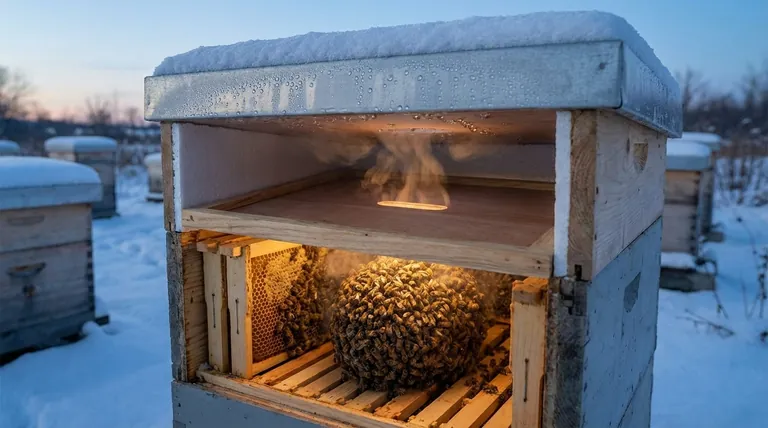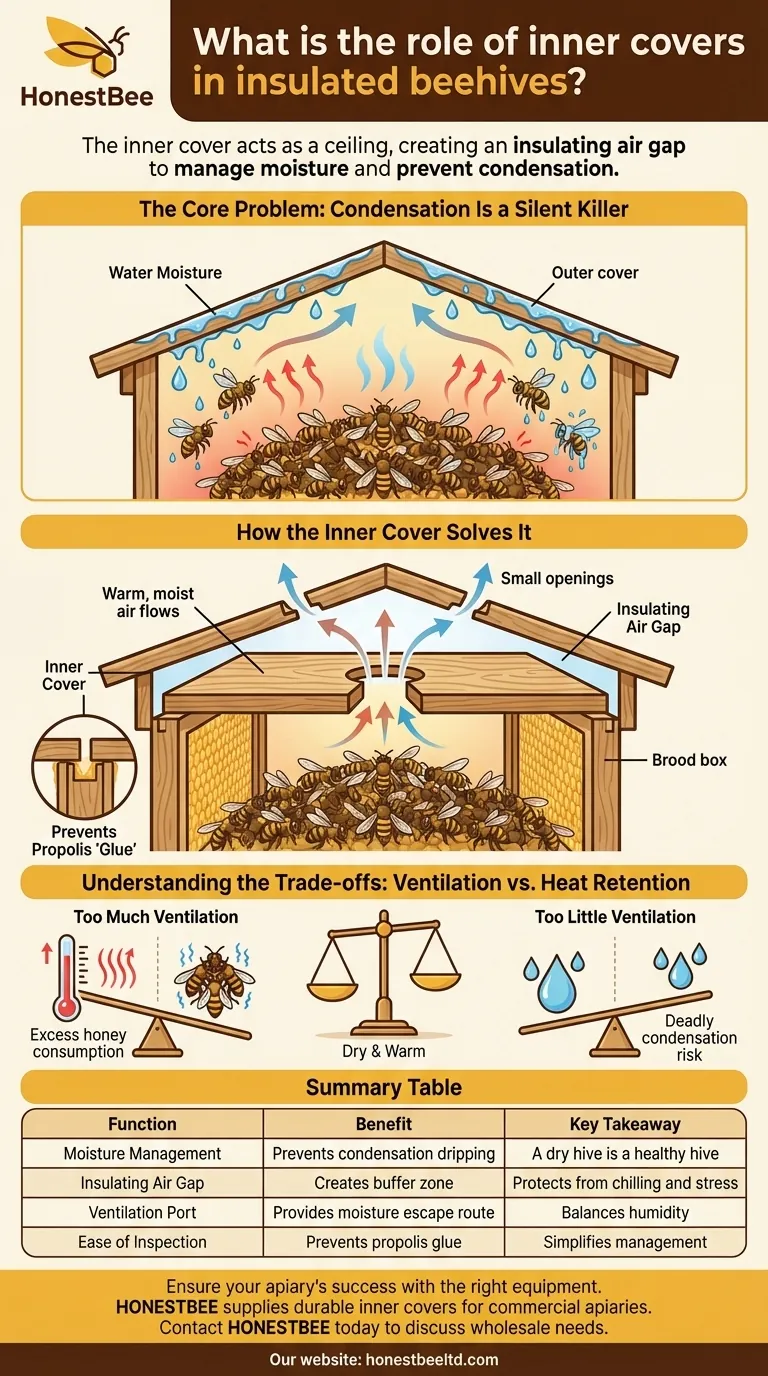In an insulated beehive, the inner cover’s primary role is to manage moisture and provide a critical layer of separation and ventilation. It acts as a ceiling for the bees, creating an insulating air gap that prevents warm, moist air from the bee cluster from hitting the cold outer cover and condensing into deadly water droplets.
The inner cover is not just a lid; it is the most critical component of the hive's climate control system. Its function is to separate the humid, warm interior from the cold exterior surfaces, thereby preventing fatal condensation from dripping back onto the bee cluster.

The Core Problem: Condensation Is a Silent Killer
A beehive in winter is a dynamic environment. Understanding the physics at play is essential for ensuring colony survival.
How a Bee Cluster Generates Heat and Moisture
To survive cold temperatures, honey bees form a tight cluster and vibrate their wing muscles. This process, fueled by honey consumption, generates significant heat, but it also releases a large amount of water vapor as a byproduct of their metabolism.
The Cold Surface "Ceiling"
This warm, moisture-laden air rises. Without an inner cover, it would directly contact the cold underside of the outer lid. This temperature difference causes the water vapor to instantly condense into liquid water, much like a cold glass of water "sweats" on a humid day.
Why Condensation Is Fatal
This condensation drips back down into the hive. A wet bee is a cold bee. Cold water raining down on the winter cluster can quickly chill the bees, leading to stress, disease, and the death of the entire colony.
How the Inner Cover Solves the Condensation Problem
The inner cover is a simple but elegant engineering solution to the problem of condensation. It works by managing the space and airflow at the top of the hive.
Creating an Insulating Air Gap
The inner cover creates a crucial pocket of air between the living space of the brood box and the cold outer cover. This "attic" space acts as a buffer zone. The air in this gap insulates the warm hive below from the cold surface above.
Providing an Escape Route for Moisture
Most inner covers have a notch or a central hole. This feature is not just for feeding; it's a vital ventilation port. It allows the warm, moist air to escape the main chamber and enter the attic space, where it can either vent out of the hive or condense harmlessly on the underside of the outer cover, away from the bees.
Preventing Propolis "Glue"
A secondary, practical function of the inner cover is to prevent the bees from sealing the outer cover to the top of the brood box with propolis. This makes hive inspections far easier and less disruptive to the colony.
Understanding the Trade-offs
Properly using an inner cover involves balancing two competing needs: heat retention and ventilation. Getting this balance wrong can be detrimental.
Ventilation vs. Heat Retention
The central challenge of wintering a hive is to vent excess moisture without losing too much precious heat. Too much ventilation forces the bees to consume more honey to stay warm. Too little ventilation leads directly to the deadly condensation problem.
The Risk of Improper Configuration
Simply having an inner cover is not enough. Its configuration matters. For example, in winter, the notched side is often oriented to create a small upper entrance, allowing moisture to escape. Using it incorrectly can trap moisture and defeat its primary purpose.
Making the Right Choice for Your Hive
Your strategy for using the inner cover should align with your specific management goals, especially concerning the season.
- If your primary focus is overwintering a colony in a cold climate: Use an inner cover to create an insulating air gap and ensure the ventilation notch allows moisture to escape from the main cluster area.
- If your primary focus is simplifying routine inspections: The inner cover provides a crucial buffer, allowing you to remove the outer cover without immediately exposing and agitating the entire colony.
Mastering the function of the inner cover transforms it from a simple piece of wood into your primary tool for ensuring a dry, healthy, and thriving colony.
Summary Table:
| Function | Benefit | Key Takeaway |
|---|---|---|
| Moisture Management | Prevents condensation from dripping onto the bee cluster. | A dry hive is a healthy hive; condensation is a silent killer. |
| Insulating Air Gap | Creates a buffer zone that separates warm interior from cold exterior. | Protects the winter cluster from chilling and stress. |
| Ventilation Port | Provides an escape route for excess moisture-laden air. | Balances hive humidity without significant heat loss. |
| Ease of Inspection | Prevents bees from gluing the outer cover to the brood box with propolis. | Simplifies hive management and reduces disruption to the colony. |
Ensure your apiary's success with the right equipment. Proper moisture management is critical for colony health and honey production. HONESTBEE supplies durable, precision-crafted inner covers and other essential beekeeping supplies to commercial apiaries and distributors through our wholesale-focused operations. Let us help you build stronger, more productive hives.
Contact HONESTBEE today to discuss your wholesale needs and optimize your hive's climate control system.
Visual Guide

Related Products
- Inner Beehive Cover for Beekeeping Bee Hive Inner Cover
- Professional Insulated Winter Hive Wrap for Beekeeping
- Stainless Steel Round Beehive Air Vents for Ventilation
- Australian Pine Wood Langstroth Screen Bottom Board for Wholesale
- Langstroth Screen Bottom Board for Beekeeping Wholesale
People Also Ask
- Why might beekeepers use an inner cover under the telescoping outer cover? Simplify Hive Management & Protect Your Colony
- What is the purpose of the inner cover in a beehive? A Key to Hive Health & Easy Management
- What are the advantages of using an inner cover in a beehive? Key Benefits for Hive Health & Beekeeper Efficiency
- What is the recommended orientation for the rim of an inner cover? Master Hive Ventilation and Insulation
- How is the inner cover used to promote ventilation? Master Hive Climate Control for Healthy Bees



















